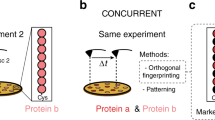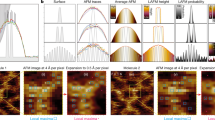Abstract
Protein charge at various pH and isoelectric point (pI) values is important in understanding protein function. However, often only trace amounts of unknown proteins are available and pI measurements cannot be obtained using conventional methods. Here, we show a method based on the atomic force microscope (AFM) to determine pI using minute quantities of proteins. The protein of interest is immobilized on AFM colloidal probes and the adhesion force of the protein is measured against a positively and a negatively charged substrate made by layer-by-layer deposition of polyelectrolytes. From the AFM force–distance curves, pI values with an estimated accuracy of ±0.25 were obtained for bovine serum albumin, myoglobin, fibrinogen and ribonuclease A over a range of 4.7–9.8. Using this method, we show that the pI of the ‘footprint’ of the temporary adhesive proteins secreted by the barnacle cyprid larvae of Amphibalanus amphitrite is in the range 9.6–9.7.
This is a preview of subscription content, access via your institution
Access options
Subscribe to this journal
Receive 12 print issues and online access
$259.00 per year
only $21.58 per issue
Buy this article
- Purchase on Springer Link
- Instant access to full article PDF
Prices may be subject to local taxes which are calculated during checkout



Similar content being viewed by others
References
Righetti, P. G. & Caravaggio, T. Isoelectric points and molecular weights of proteins: a table. J. Chromatogr. A 127, 1–28 (1976).
Hughes, A. J., Tentori, A. M. & Herr, A. E. Bistable isoelectric point photoswitching in green fluorescent proteins observed by dynamic immunoprobed isoelectric focusing. J. Am. Chem. Soc. 134, 17582–17591 (2012).
Righetti, P. G. Determination of the isoelectric point of proteins by capillary isoelectric focusing. J. Chromatogr. A 1037, 491–499 (2004).
Mohan, D. & Lee, C. S. Extension of separation range in capillary isoelectric focusing for resolving highly basic biomolecules. J. Chromatogr. A 979, 271–276 (2002).
Shen, Y. & Smith, R. D. Proteomics based on high-efficiency capillary separations. Electrophoresis 23, 3106–3124 (2002).
Righetti, P. G., Gelfi, C. & Conti, M. Protein purification: principles, high resolution methods, and applications. J. Chromatogr. B 699, 91–104 (1997).
Pihlasalo, S., Auranen, L., Hanninen, P. & Harma, H. Method for estimation of protein isoelectric point. Anal. Chem. 84, 8253–8258 (2012).
Callow, J. A. & Callow, M. E. Trends in the development of environmentally friendly fouling-resistant marine coatings. Nature Commun. 2, 244 (2011).
Smith, C. Striving for purity: advances in protein purification. Nature Methods 2, 71–77 (2005).
De, M. et al. Sensing of proteins in human serum using conjugates of nanoparticles and green fluorescent protein. Nature Chem. 1, 461–465 (2009).
Yan, J. et al. Effect of proteins with different isoelectric points on the gene transfection efficiency mediated by stearic acid grafted chitosan oligosaccharide micelles. Mol. Pharm. 10, 2568–2577 (2013).
Butt, H. J., Cappella, B. & Kappl, M. Force measurements with the atomic force microscope: technique, interpretation and applications. Surf. Sci. Rep. 59, 1–152 (2005).
Lee, H., Scherer, N. F. & Messersmith, P. B. Single-molecule mechanics of mussel adhesion. Proc. Natl Acad. Sci. USA 103, 12999–13003 (2006).
Beaussart, A. et al. Quantifying the forces guiding microbial cell adhesion using single-cell force spectroscopy. Nature Protocols 9, 1049–1055 (2014).
Xu, L. C. & Siedlecki, C. A. Effects of surface wettability and contact time on protein adhesion to biomaterial surfaces. Biomaterials 28, 3273–3283 (2007).
Yersin, A. et al. Interactions between synaptic vesicle fusion proteins explored by atomic force microscopy. Proc. Natl Acad. Sci. USA 100, 8736–8741 (2003).
Vezenov, D. V., Noy, A., Rozsnyai, L. F. & Lieber, C. M. Force titrations and ionization state sensitive imaging of functional groups in aqueous solutions by chemical force microscopy. J. Am. Chem. Soc. 119, 2006–2015 (1997).
Ahimou, F., Denis, F. A., Touhami, A. & Dufrêne, Y. F. Probing microbial cell surface charges by atomic force microscopy. Langmuir 18, 9937–9941 (2002).
Zhu, X. et al. Polyion multilayers with precise surface charge control for antifouling. ACS Appl. Mater. Interfaces 7, 852–861 (2015).
Zhu, X., Jańczewski, D., Lee, S. S. C., Teo, S. L. M. & Vancso, G. J. Cross-linked polyelectrolyte multilayers for marine antifouling applications. ACS Appl. Mater. Interfaces 5, 5961–5968 (2013).
Barattin, R. & Voyer, N. Chemical modifications of AFM tips for the study of molecular recognition events. Chem. Commun. 13, 1513–1532 (2008).
Patel, A. B. et al. Influence of architecture on the kinetic stability of molecular assemblies. J. Am. Chem. Soc. 126, 1318–1319 (2004).
Steiner, P. et al. Interactions between NEEP21, GRIP1 and GluR2 regulate sorting and recycling of the glutamate receptor subunit GluR2. EMBO J. 24, 2873–2884 (2005).
Roach, P., Farrar, D. & Perry, C. C. Interpretation of protein adsorption: surface-induced conformational changes. J. Am. Chem. Soc. 127, 8168–8173 (2005).
Rabe, M., Verdes, D. & Seeger, S. Understanding protein adsorption phenomena at solid surfaces. Adv. Colloid Interface Sci. 162, 87–106 (2011).
Liu, H. & Hu, N. Interaction between myoglobin and hyaluronic acid in their layer-by-layer assembly: quartz crystal microbalance and cyclic voltammetry studies. J. Phys. Chem. B 110, 14494–14502 (2006).
Belfort, G. & Lee, C. S. Attractive and repulsive interactions between and within adsorbed ribonuclease A layers. Proc. Natl Acad. Sci. USA 88, 9146–9150 (1991).
Merkel, R., Nassoy, P., Leung, A., Ritchie, K. & Evans, E. Energy landscapes of receptor–ligand bonds explored with dynamic force spectroscopy. Nature 397, 50–53 (1999).
Gergely, C. et al. Unbinding process of adsorbed proteins under external stress studied by atomic force microscopy spectroscopy. Proc. Natl Acad. Sci. USA 26, 10802–10807 (2000).
Noy, A., Frisbie, C. D., Rozsnyai, L. F., Wrighton, M. S. & Lieber, C. M. Chemical force microscopy: exploiting chemically-modified tips to quantify adhesion, friction, and functional group distributions in molecular assemblies. J. Am. Chem. Soc. 117, 7943–7951 (1995).
Frisbie, C. D., Rozsnyai, L. F., Noy, A., Wrighton, M. S. & Lieber, C. M. Functional group imaging by chemical force microscopy. Science 265, 2071–2073 (1994).
Cappella, B. & Dietler, G. Force–distance curves by atomic force microscopy. Surf. Sci. Rep. 34, 1–104 (1999).
Sui, X., Chen, Q., Hempenius, M. A. & Vancso, G. J. Probing the collapse dynamics of poly(N-isopropylacrylamide) brushes by AFM: effects of co-nonsolvency and grafting densities. Small 7, 1440–1447 (2011).
Erikson, H. P. Size and shape of protein molecules at the nanometer level determined by sedimentation, gel filtration, and electron microscopy. Biol. Proced. Online 11, 32–51 (2009).
Guo, S. et al. Barnacle larvae exploring surfaces with variable hydrophilicity: influence of morphology and adhesion of ‘footprint’ proteins by AFM. ACS Appl. Mater. Interfaces 6, 13667–13676 (2014).
Neihof, R. A. & Loeb, G. I. The surface charge of particulate matter in seawater. Limnol. Oceanogr. 17, 7–16 (1972).
Rosenberg, M. & Kjelleberg, S. Hydrophobic interactions: role in bacterial adhesion. Adv. Microb. Ecol. 9, 353–393 (1986).
Shi, H., Liu, J., Geng, J., Tang, B. Z. & Liu, B. Specific detection of integrin αvβ3 by light-up bioprobe with aggregation-induced emission characteristics. J. Am. Chem. Soc. 134, 9569–9572 (2012).
Barua, S. et al. Particle shape enhances specificity of antibody-displaying nanoparticles. Proc. Natl Acad. Sci. USA 110, 3270–3275 (2013).
Zhu, G., Mallery, S. R. & Schwendeman, S. P. Stabilization of proteins encapsulated in injectable poly (lactide-co-glycolide). Nature Biotechnol. 18, 52–57 (2000).
Wasilewska, M., Adamczyk, Z. & Jachimska, B. Structure of fibrinogen in electrolyte solutions derived from dynamic light scattering (DLS) and viscosity measurements. Langmuir 25, 3698–3704 (2009).
Scheraga, H. A. & Laskowski, M. J. The fibrinogen–fibrin conversion. Adv. Protein. Chem. 12, 1–131 (1957).
Caulfield, J. P. & Farquhar, M. G. Distribution of anionic sites in glomerular basement membranes: their possible role in filtration and attachment. Proc. Natl Acad. Sci. USA 73, 1646–1650 (1976).
Liu, Q. et al. Graphene and graphene oxide sheets supported on silica as versatile and high-performance adsorbents for solid-phase extraction. Angew. Chem. Int. Ed. 123, 6035–6039 (2011).
Wright, A. T. & Anslyn, E. A. Differential receptor arrays and assays for solution-based molecular recognition. Chem. Soc. Rev. 35, 14–28 (2006).
Wang, C. & Lucy, C. A. Oligomerized phospholipid bilayers as semipermanent coatings in capillary electrophoresis. Anal. Chem. 77, 2015–2021 (2005).
Ravindra, R., Zhao, S., Gies, H. & Winter, R. Protein encapsulation in mesoporous silicate: the effects of confinement on protein stability, hydration, and volumetric properties. J. Am. Chem. Soc. 126, 12224–12225 (2004).
Hutter, J. L. & Bechhoefer, J. Calibration of atomic-force microscope tips. Rev. Sci. Instrum. 64, 1868–1873 (1993).
Acknowledgements
The authors are grateful to the Agency for Science, Technology and Research (A*STAR) for providing financial support under the Innovative Marine Antifouling Solutions (IMAS) program.
Author information
Authors and Affiliations
Contributions
G.J.V. supervised the project. D.J. and G.J.V. conceived the approach, evaluated the results and corrected the manuscript. S.G. conceived the approach, designed the experiments, analysed the data and wrote the paper. X.Z. designed the experiments and fabricated the surfaces. S.S.C.L. cultured the barnacle cyprids. T.H. contributed to the probe modification and discussion. S.L.M.T. evaluated and commented on the results. S.G. and X.Z. contributed equally to this work.
Corresponding authors
Ethics declarations
Competing interests
The authors declare no competing financial interests.
Supplementary information
Supplementary information
Supplementary information (PDF 1328 kb)
Rights and permissions
About this article
Cite this article
Guo, S., Zhu, X., Jańczewski, D. et al. Measuring protein isoelectric points by AFM-based force spectroscopy using trace amounts of sample. Nature Nanotech 11, 817–823 (2016). https://doi.org/10.1038/nnano.2016.118
Received:
Accepted:
Published:
Issue Date:
DOI: https://doi.org/10.1038/nnano.2016.118
This article is cited by
-
Atomic force and infrared spectroscopic studies on the role of surface charge for the anti-biofouling properties of polydopamine films
Analytical and Bioanalytical Chemistry (2023)
-
3D printed vision-based micro-force sensors for microrobotic applications
Journal of Micro and Bio Robotics (2022)
-
Towards a real-time 3D vision-based micro-force sensing probe
Journal of Micro-Bio Robotics (2020)
-
Atomic force microscopy-based characterization and design of biointerfaces
Nature Reviews Materials (2017)
-
Net charge of trace proteins
Nature Nanotechnology (2016)



